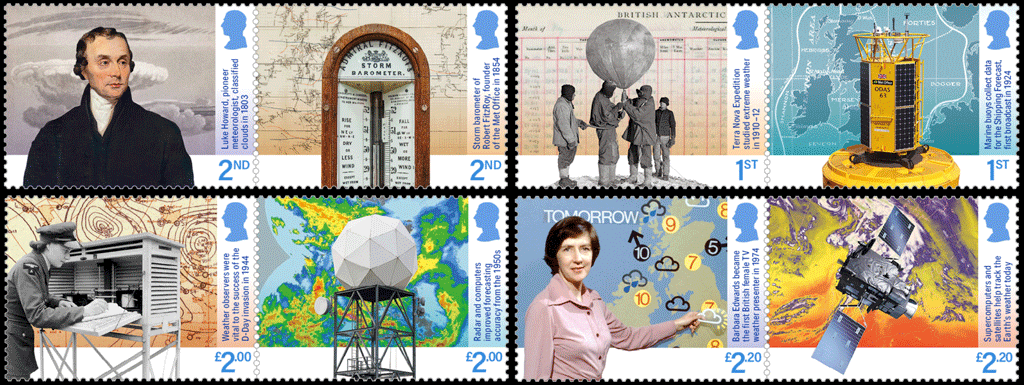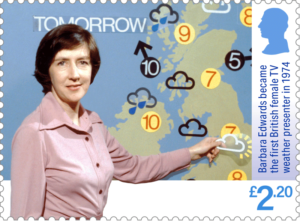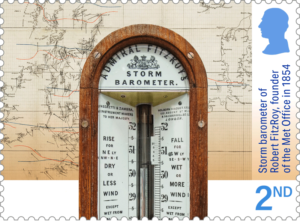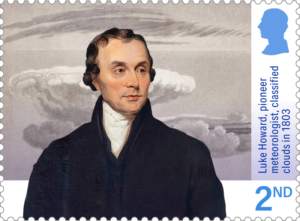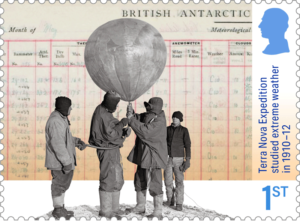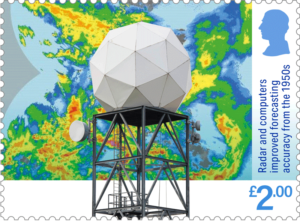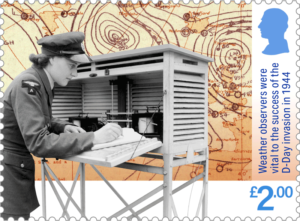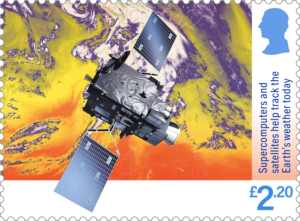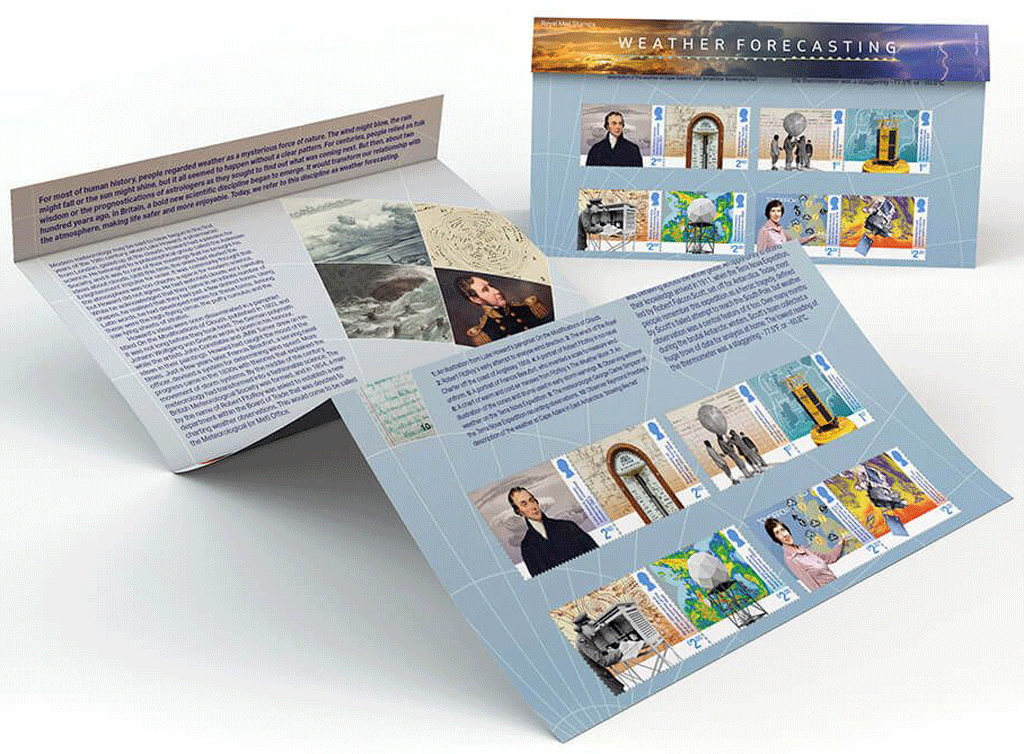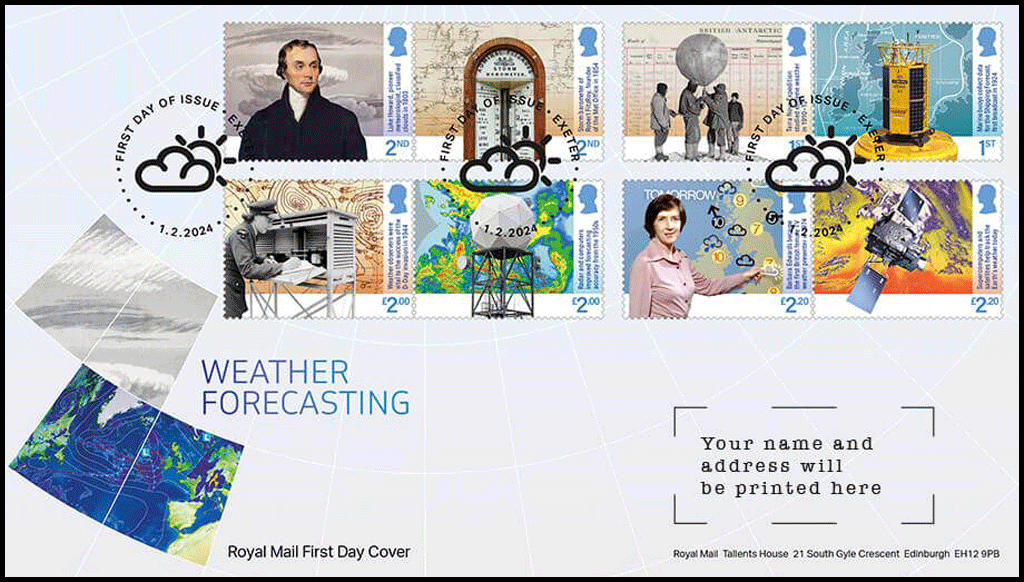[press release] [click on any of the pictures for larger versions]
Legacy of the Vikings in Britain Celebrated with a Set of Eight Special Stamps from Royal Mail
- Issue date: 20 February 2024
- The stamps also mark the 40th anniversary of the JORVIK Viking Centre opening in York
- Featuring striking images, the stamps showcase Viking artefacts and locations of significance from around the UK
- The stamps and a range of collectible products are available to pre-order now at www.royalmail.com/vikingbritain and by telephone on 03457 641641
 Royal Mail has revealed images of eight new stamps that celebrate the history, impact and legacy of Vikings in Britain and mark 40 years since the JORVIK Viking Centre opened in York.
Royal Mail has revealed images of eight new stamps that celebrate the history, impact and legacy of Vikings in Britain and mark 40 years since the JORVIK Viking Centre opened in York.
Featuring striking images, the stamps showcase Viking artefacts and locations of significance from around the UK, and include:
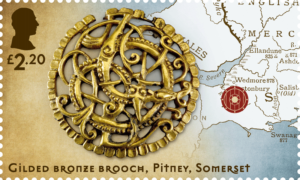 an iron, silver and copper sword
an iron, silver and copper sword- a silver penny minted in York
- Silver penannular brooch, Penrith, Cumbria
- Lindisfarne Priory in Northumberland
- Norse settlement remains in Jarlshof, Shetland
- an antler comb and case from Coppergate, York
- Gilded bronze brooch, Pitney, Somerset
- a Hogback gravestone from Govan Old, Glasgow
The Coppergate Dig that began in May 1976, led directly to the creation on the excavation site of the JORVIK Viking Centre, to showcase the finds and recreate the urban landscape 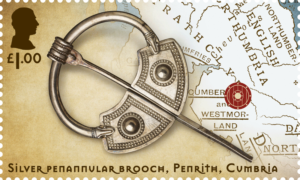 of Viking Age York – including its sounds and smells – all based on detailed research.
of Viking Age York – including its sounds and smells – all based on detailed research.
When it opened, the Centre made a global impact. It showed that the Viking world was based on more than violence, and told a complex story of settlement, manufacture and trade.
Opening in 1984, JORVIK welcomed 900,000 people during its first year of operation. Over the intervening decades, and after three updates, the Centre has entertained and i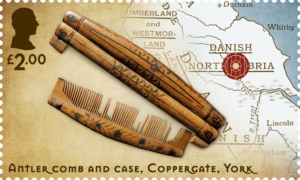 nteracted with over 20 million visitors, including many children.
nteracted with over 20 million visitors, including many children.
In addition to the team at the JORVIK Viking Centre, Royal Mail also worked closely with Dr Gareth Williams, curator at the British Museum and Thomas Williams, author of Viking Britain and Viking London, and previously also a curator at the British Museum.
Viking Britain:
The Vikings were seaborne adventurers of Scandinavian origin whose activities in the 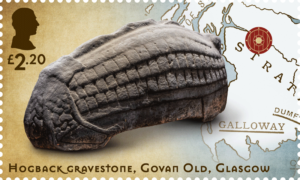 British Isles from the end of the 8th century onwards changed the languages, economy, society and political geography of these islands forever.
British Isles from the end of the 8th century onwards changed the languages, economy, society and political geography of these islands forever.
Early raids targeted Christian monasteries and coastal communities but, by the mid-9th century, these incursions had evolved into large-scale invasions that tore up the traditional patchwork of small independent kingdoms.
The waves of migration, settlement and conquest that followed transformed Britain; by the 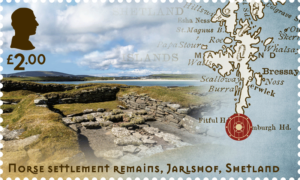 early 11th century, kings and earls of Danish and Norwegian heritage ruled the whole of England and large parts of Scotland and dominated the Irish Sea. And while ultimately the sounding horns of the Viking Age fell silent, the echoes still remain.
early 11th century, kings and earls of Danish and Norwegian heritage ruled the whole of England and large parts of Scotland and dominated the Irish Sea. And while ultimately the sounding horns of the Viking Age fell silent, the echoes still remain.
David Gold, Director of External Affairs and Policy said: “If anyone was to ask ‘what did the Vikings ever do for us?’ the answer is that they transformed Britain and left an enduring influence on the languages, economy, society and political geography  of the UK forever. Their impact was enormous and cannot be overlooked. We hope these stamps will inspire people to explore this fascinating period in Britain’s history further.”
of the UK forever. Their impact was enormous and cannot be overlooked. We hope these stamps will inspire people to explore this fascinating period in Britain’s history further.”
David Jennings, Chief Executive of York Archaeology, the charity that operates JORVIK Viking Centre, commented: “T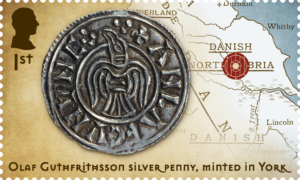 he finds at Coppergate fundamentally changed our understanding of how the Vikings lived in England, and JORVIK Viking Centre put York’s Norse heritage on the international map. After over 40 years, and with over 20 million visitors passing through our doors, it is a real honour to be featured on these stamps and be part of this unique celebration of Viking culture.”
he finds at Coppergate fundamentally changed our understanding of how the Vikings lived in England, and JORVIK Viking Centre put York’s Norse heritage on the international map. After over 40 years, and with over 20 million visitors passing through our doors, it is a real honour to be featured on these stamps and be part of this unique celebration of Viking culture.”
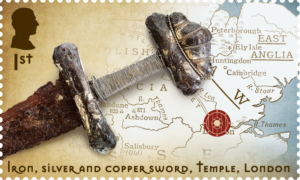 The stamps, and a range of collectible products, are available to pre-order now at www.royalmail.com/vikingbritain and by telephone on 03457 641 641. A Presentation Pack including all eight stamps in the set is priced at £13.80. The stamps go on general sale on 20 February.
The stamps, and a range of collectible products, are available to pre-order now at www.royalmail.com/vikingbritain and by telephone on 03457 641 641. A Presentation Pack including all eight stamps in the set is priced at £13.80. The stamps go on general sale on 20 February.
Philatelic Products:
Stamp Set: £12.90
Presentation Pack: £13.80
First Day Cover [below]: £16.15
Stamp Souvenir: £16.15
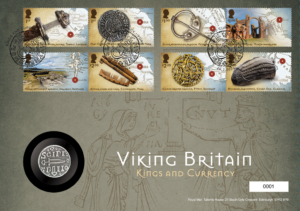 First Day Envelope: £0.30
First Day Envelope: £0.30
Postcards: £3.60
Framed Stamps: £34.99
Medal Cover [right]— Replica Viking Coin from York: £19.99
Full Sheet 60 x 1st Class Stamps: £75.00
Half Sheet 30 x 1st Class Stamps: £37.50
Full Sheet 60 x £1.00 Stamps: £60.00
Half Sheet 30 x £1.00 Stamps: £30.00
Full Sheet 60 x £2.00 Stamps: £120.00
Half Sheet 30 x £2.00 Stamps: £60.00
Full Sheet 60 x £2.20 Stamps: £132.00
Half Sheet 30 x £2.20 Stamps: £66.00
Technical details:
| Number of stamps Value of Stamps Design Format Number per sheet Size Printer Process Perforations Phosphor Gum Stamp designs |
Eight 2 x 1st Class, 2 x £1.00, 2 x £2.00, 2 x £2.20 Studio Up landscape 30/60 50mm x 30mm Cartor Security Printers lithography 14 x 14 bars as appropriate PVA Stamp designs © Royal Mail Group Ltd 2024 |
Acknowledgements: Iron, silver and copper sword, Silver penny, Silver penannular brooch and Gilded bronze brooch © The Trustees of the British Museum; Lindisfarne Priory © 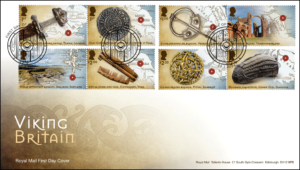 AJM681/Alamy Stock Photo. Featured with kind permission of English Heritage; Norse settlement remains © Chris Griffiths/Getty Images; Antler comb and case © York Archaeological Trust for Excavation and Research Limited; Hogback gravestone © Alan McAteer. Featured with kind permission of Govan Old; Vintage paper texture © Javarman/Alamy Stock Photo; ‘Time of Viking Invasions’ map, from History of England by George Macaulay Trevelyan. Longmans, Green and Co. Ltd, London, 1926 © The Print Collector/Alamy Stock Photo; Antique map of Shetland and Orkney Islands © ilbusca/Getty Images
AJM681/Alamy Stock Photo. Featured with kind permission of English Heritage; Norse settlement remains © Chris Griffiths/Getty Images; Antler comb and case © York Archaeological Trust for Excavation and Research Limited; Hogback gravestone © Alan McAteer. Featured with kind permission of Govan Old; Vintage paper texture © Javarman/Alamy Stock Photo; ‘Time of Viking Invasions’ map, from History of England by George Macaulay Trevelyan. Longmans, Green and Co. Ltd, London, 1926 © The Print Collector/Alamy Stock Photo; Antique map of Shetland and Orkney Islands © ilbusca/Getty Images

